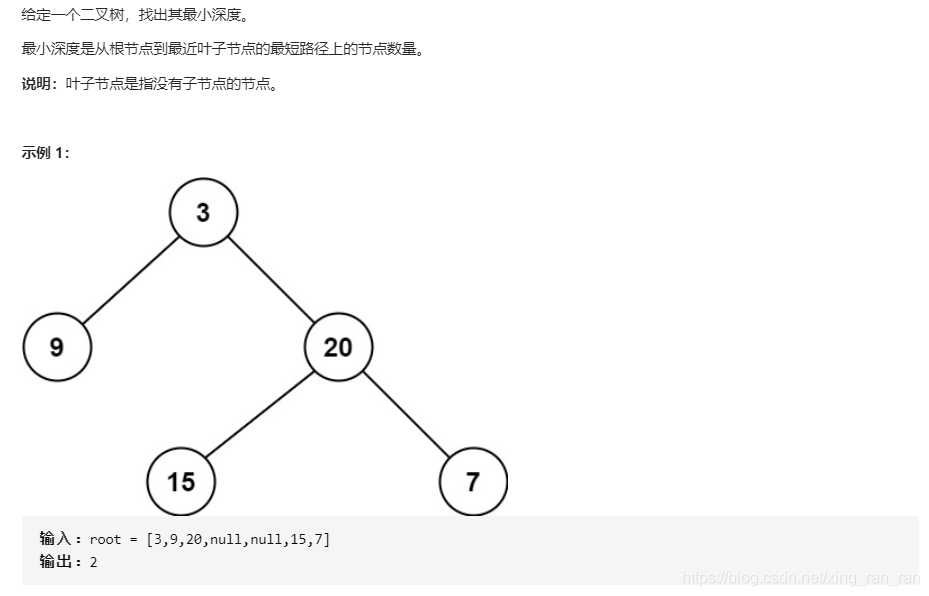
思路1:深度优先搜索
首先可以想到使用深度优先搜索的方法,遍历整棵树,记录最小深度。
对于每一个非叶子节点,我们只需要分别计算其左右子树的最小叶子节点深度。这样就将一个大问题转化为了小问题,可以递归地解决该问题。
——时间复杂度:O(N) 其中 N 是树的节点数。对每个节点访问一次。
——空间复杂度:O(H) 其中 H 是树的高度。空间复杂度主要取决于递归时栈空间的开销,最坏情况下,树呈现链状,空间复杂度为 O(N)。平均情况下树的高度与节点数的对数正相关,空间复杂度为 O(logN)
/**
* Definition for a binary tree node.
* public class TreeNode {
* int val;
* TreeNode left;
* TreeNode right;
* TreeNode() {}
* TreeNode(int val) { this.val = val; }
* TreeNode(int val, TreeNode left, TreeNode right) {
* this.val = val;
* this.left = left;
* this.right = right;
* }
* }
*/
class Solution {
public int minDepth(TreeNode root) {
if (root == null) {
return 0;
}
if (root.left == null && root.right == null) {
return 1;
}
int min_depth = Integer.MAX_VALUE;
if (root.left != null) {
min_depth = Math.min(minDepth(root.left), min_depth);
}
if (root.right != null) {
min_depth = Math.min(minDepth(root.right), min_depth);
}
return min_depth + 1;
}
}
√思路2:广度优先搜索
当我们找到一个叶子节点时,直接返回这个叶子节点的深度。广度优先搜索的性质保证了最先搜索到的叶子节点的深度一定最小。
——时间复杂度:O(N) 其中 N 是树的节点数。对每个节点访问一次。
——空间复杂度:O(N) 其中 N 是树的节点数。空间复杂度主要取决于队列的开销,队列中的元素个数不会超过树的节点数。
/**
* Definition for a binary tree node.
* public class TreeNode {
* int val;
* TreeNode left;
* TreeNode right;
* TreeNode() {}
* TreeNode(int val) { this.val = val; }
* TreeNode(int val, TreeNode left, TreeNode right) {
* this.val = val;
* this.left = left;
* this.right = right;
* }
* }
*/
class Solution {
class QueueNode {
TreeNode node;
int depth;
public QueueNode(TreeNode node, int depth) {
this.node = node;
this.depth = depth;
}
}
public int minDepth(TreeNode root) {
if (root == null) {
return 0;
}
Queue<QueueNode> queue = new LinkedList<QueueNode>();
queue.offer(new QueueNode(root, 1));
while (!queue.isEmpty()) {
QueueNode nodeDepth = queue.poll();
TreeNode node = nodeDepth.node;
int depth = nodeDepth.depth;
if (node.left == null && node.right == null) {
return depth;
}
if (node.left != null) {
queue.offer(new QueueNode(node.left, depth + 1));
}
if (node.right != null) {
queue.offer(new QueueNode(node.right, depth + 1));
}
}
return 0;
}
}





 本文探讨了两种解决LeetCode中111题——二叉树最小深度的方法:深度优先搜索(DFS)和广度优先搜索(BFS)。对于DFS,每个非叶子节点的最小深度通过递归计算其子树得到,时间复杂度为O(N),空间复杂度为O(H)。而BFS则在找到第一个叶子节点时返回其深度,时间复杂度同样为O(N),但空间复杂度为O(N)。
本文探讨了两种解决LeetCode中111题——二叉树最小深度的方法:深度优先搜索(DFS)和广度优先搜索(BFS)。对于DFS,每个非叶子节点的最小深度通过递归计算其子树得到,时间复杂度为O(N),空间复杂度为O(H)。而BFS则在找到第一个叶子节点时返回其深度,时间复杂度同样为O(N),但空间复杂度为O(N)。
















 8万+
8万+

 被折叠的 条评论
为什么被折叠?
被折叠的 条评论
为什么被折叠?








